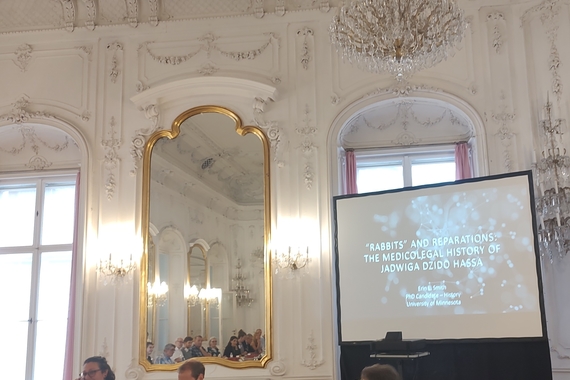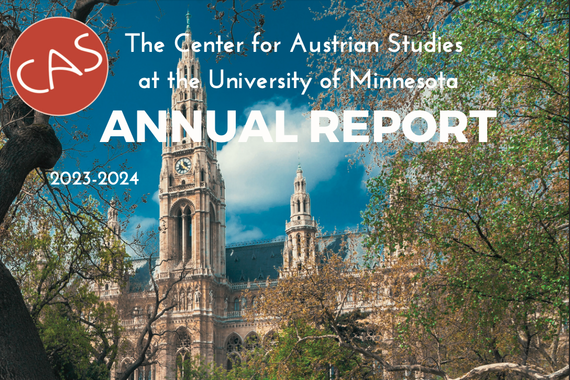CAS Exclusive: "Emperor Joseph's Solution to Coronavirus"
Originally published April 11, 2020 in the Wall Street Journal
We have been given permission to repost the article here at the Center for Austrian Studies.
Enjoy the read, and Congratulations Dr. Ingrao and Dr. Mitchell!
As countries around the world frantically erect barriers against the spread of the novel coronavirus, it might be helpful to look at one of the most successful quarantine systems ever created. In 1710 Emperor Joseph I decided to block the chronic spread of diseases from the Balkans by creating a continuous “sanitary cordon” along the Habsburg monarchy’s southern frontier with the Ottoman Empire. His action failed to save him; he died of smallpox in April 1711 after he huddled with his prime minister, who was unaware that his daughter had just contracted the disease. No one then knew much about “social distancing.” Nonetheless, the empire’s sanitary cordon outlived him by a century and a half.
The system Joseph created had several strengths. In an age when most international borders were defined only by overlapping feudal jurisdictions, the Habsburg-Ottoman frontier was a visibly delineated thousand-mile line of rivers, mountain peaks and border markers posted by a bilateral peace commission. It was already a military zone with extensive fortresses and army garrisons, which not only defended against Turkish raids but enforced customs and the processing of Christian refugees fleeing Ottoman rule.
A sense of the scale of this operation can be seen by comparing it with the American border today. Whereas we rely on 21,000 U.S. Border Patrol agents stretched tenuously across the long Mexican and Canadian frontiers, as many as 100,000 fierce, colorfully clad Serb and Croat infantrymen were available to guard a southern Habsburg border zone that was typically dozens of miles deep.
By the middle of the 18th century, 2,000 fortified watchtowers stood every half mile, punctuated by 19 border crossings with facilities that registered, housed and isolated everyone entering for at least 21 days before granting them passports to enter the empire’s territory. Quarters were disinfected daily with sulfur or vinegar and trade goods graded on their susceptibility to transmitting germs. Habsburg agents posted to Ottoman territory provided intelligence that enabled officials to adjust quarantine times—or even temporarily suspend them.
The rules were strictly enforced. One English observer noted: “If you dare to break the laws of the quarantine, you will be tried with military haste; the court will scream out a sentence to you from a tribunal some fifty yards off . . . and after that you will find yourself carefully shot and carelessly buried.”
Until 1881 the Habsburg Military Frontier played many roles, acting as a barrier to illegal immigration, an early warning system against Ottoman raids, and a source of superb irregulars to fight Austria’s wars. But it was in fighting epidemics that it arguably made its greatest, largely unheralded contribution. In the century and a half before the frontier’s permanent establishment, the plague alone had entered Europe from the Near East on at least eight occasions; afterward, no major outbreaks occurred. At least five times, epidemics in the Ottoman and Russian empires were stopped cold at the empire’s border.
The cordon became a place where epidemics could be systematically studied. One admirer was Napoleon. Best known for destroying his enemies and their institutions, he adopted it during his occupation of Egypt (1798) then ordered that it “be preserved in its entirety” following France’s annexation of Croatia (1810-13).
The reasons for the cordon’s demise would be recognizable in our own time. It was assaulted by both liberals (because it impeded trade) and nationalists in Hungary and Croatia (because it gave control of the border to the government in Vienna). After the empire split into Austrian and Hungarian halves, Hungary abolished the institution.
The Habsburg experience holds insights for our time. One is the need to foresee rather than react to threats. Another is that physical space matters in fighting epidemics. Hard as it is to swallow for Western publics habituated to globalization, well-regulated, rational borders contribute substantially to the public good. Early critics of the Trump administration’s travel restrictions failed to appreciate the urgent medical rationale. As Anthony Fauci testified to Congress, no public-health strategy can contain a contagion already inside the country without stopping the influx of new carriers.
Another is that epidemics are not only about public health; they are also about geopolitics. For the Habsburg authorities, their management was also a security issue. The monarchy’s position vis-à-vis the Ottoman Empire parallels the West’s current relationship with China insofar as the world’s worst contagions—SARS (2002-03), avian flu (2005) and now Covid-19—originate from a power that is also a strategic rival. It is no accident that Italy, the first and hardest hit European country, is also one of Beijing’s closest partners in the European Union, with some of the heaviest China-bound air traffic in Europe. In the aftermath of this crisis, epidemics must be taken more seriously as a security threat, even as the West looks for the right balance in a trade relationship that must involve less reliance on Chinese supply chains.
Finally, the Habsburg experience shows that fighting epidemics does not have to come at the expense of alliances, international trade or civilization in the broadest sense, as some fear. Long before airport quarantines and the seamless passage of containerized cargo, the Habsburgs effectively fought irruptions of the plague from the east while maintaining an orderly system of trade with the Ottomans, keeping largely open borders within their own empire (a kind of proto-Schengen zone), managing a well-regulated system of trade and diplomacy with their western neighbors, and developing one of the most cosmopolitan civilizations in history.
We should have a similar aim today, even as we prioritize getting a handle on the immediate, deadly impact of Covid-19.


